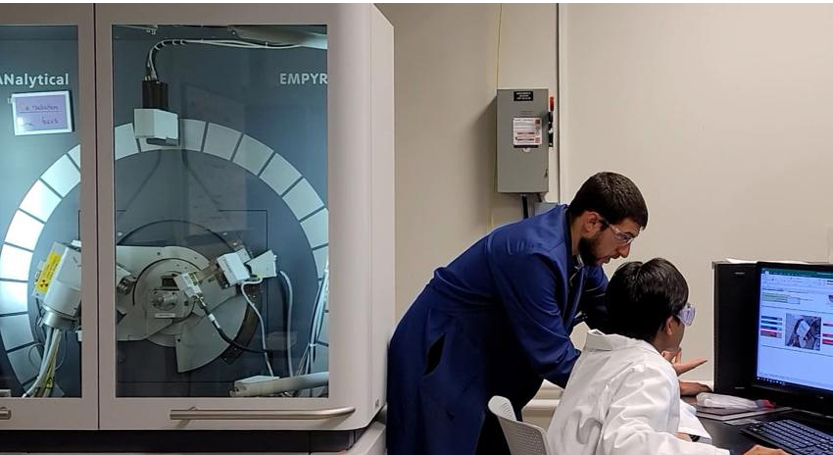
One of the more innovative energy-saving tools at Penn State was not implemented by a faculty member, employee, or graduate student. Instead, it was developed by undergraduate students who are part of an innovative and unique research fellowship offered by the Materials Research Institute (MRI).
MRI’s Undergraduate Research Fellowship is unique in that it offers undergraduate students an opportunity to receive training and use the high-end scientific instrumentation available in the Millennium Science Complex. This is something only students at a graduate level usually have access to. Each of the undergraduate fellows are assigned a few main projects for their time working with MRI faculty and research staff, and this included the innovative energy-saving idea, which was a sensor for laboratory fume hoods to make sure the fume hood sash was closed when not in use.
However, the fellowship experience is not limited to their assigned projects. They are exposed to various research projects that enable them to receive hands-on experiential learning working with research staff in MRI’s core facilities. And beyond this, they also receive opportunities to work with some of the approximately 1,000 researchers from 45 Penn State departments doing cutting-edge research work at the University. They also have opportunities to interact with MRI’s more than 100 external research partners from other higher education institutions and industry, giving them valuable contacts and resume points for future employment and graduate school searches.
The fellowship is the brainchild of its director, Maxwell Wetherington, assistant research professor, molecular spectroscopy. Wetherington was inspired to create the program after recalling his own Penn State student experience, which included earning a bachelor of science degree in engineering science, a master of science degree in material science and engineering, and a doctor of philosophy degree in materials science and engineering.
“I help support this capability, including learning how to operate the microscopes and troubleshoot them, which is important because it takes some time to learn all the machines’ quirks and how to mitigate them for the remote users,” Misra said. “Perhaps most importantly, I’ve learned when to know I can’t solve something, and more advanced maintenance is needed.”
Each year, five undergraduate students are selected as fellows. For the 2022-2023 version of the program that ended in May 2023, the students included Muhammad Ishak, third-year materials science and engineering; Harshit Jain, third-year computer science; Jongkyeong Kim, third-year year materials science and engineering; Baaz Misra, second-year computer science and engineering; and Alejandro Toro, third-year material science and engineering.
Kim’s work during his fellowship included the fume hood sensor. He was inspired by some of his sustainability coursework that taught him that fume hoods have some of the greatest impact on energy use in a lab. This is due to the amount of energy required to keep a consistent airflow to remove hazardous fumes in a lab. Closing the sash when the lab is not in use reduces the volume of air that needs to be treated and exhausted, thus saving energy.
Ishak’s project enabled him to work with a faculty member outside of Penn State, Tom Mallouk, currently the chair of the Department of Chemistry at the University of Pennsylvania. Like Kim, his project had an immediate impact on research at Penn State.
"I worked together with Mallouk to improve the accuracy and reproducibility of our Helium pycnometer, which measures the density and mass of solids, to develop a new, standardized operating procedure for that instrument,” Ishak said.
For Jain, his projects put into practice what he has learned as a computer science major, especially around machine learning and artificial intelligence. One was developing an innovative web application that allows a researcher anywhere in the United States to find a specific research instrument near their location.
The other computer science-focused Fellow, Misra, credits the program in part with his switching to his current major from electrical engineering. Misra’s project work included supporting remote transmission electron microscopy, which involves users outside of University Park logging into a system that enables them to control the microscopes remotely.
Toro also worked with remote users at Penn State Harrisburg on scanning electron microscopy (SEM) and related focused ion beam work, along with prepping samples to be
characterized by these tools.
“Right now, professors at Harrisburg are able to commission projects and research to be done on the SEM microscopes and focused ion beam for their own research,” Toro said. “Through the fellowship, I can save these researchers time and money since they can do this work on our instruments remotely, so they do not have to travel to University Park from Harrisburg.”
For more information on the program and to learn more about industry sponsorships, contact Wetherington at mtw5027@psu.edu or David Fecko, director of MRI industry collaboration, at dlf5023@psu.edu.
This article appeared in FOCUS on MATERIALS , Spring 2023.

